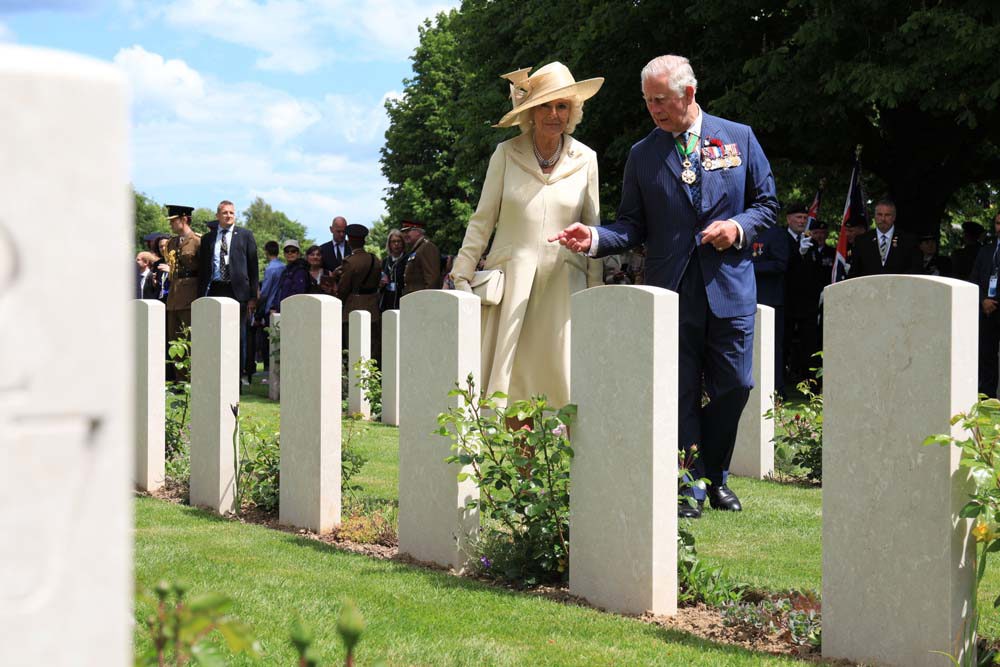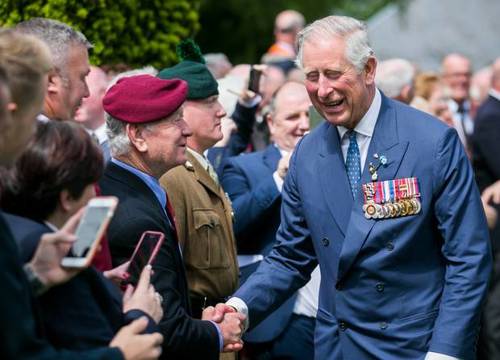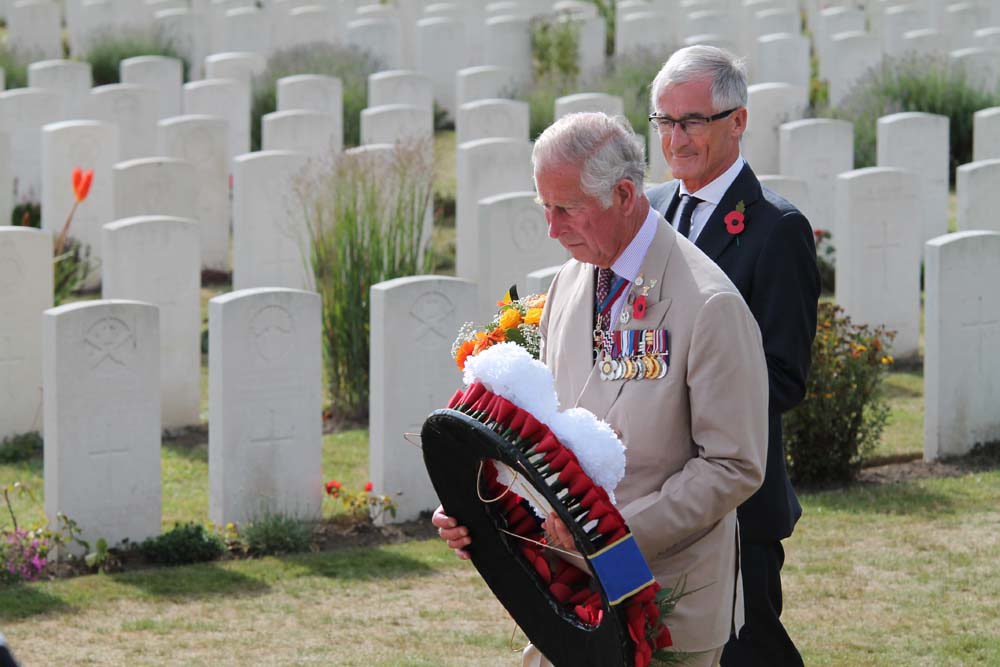01 May 2023
By Royal Approval: Celebrating King Charles III’s visits to Commonwealth War Graves Sites
As we prepare to celebrate His Majesty King Charles III’s coronation, we look back at some of the recent times he has visited CWGC sites across the globe.
King Charles III & the Commonwealth War Graves Commission
A royal connection

King Charles in his former capacity as the Prince of Wales visits Bayeux War Cemetery for the 75th D-Day Anniversary celebrations (MoD)
The Commonwealth War Graves Commission was founded by Royal Charter in 1917.
We have had a long and fruitful relationship with the Royal Family since our inception. The Duke of Kent has been our President for more than 50 years and is a tireless champion of our work.
We have always found the Royals to be evangelical about the importance of preserving war graves, war memorials, and the memories of those we commemorate.
King George V undertook a trip known as the King’s Pilgrimage 100 years ago to visit our nascent sites. Since then, members of the Royal Family have been keen visitors to our sites.

Queen Elizabeth II was a regular visitor too. For over five decades, Her Majesty attended ceremonies and visits to CWGC cemeteries and memorials. In fact, one of the Queen’s earliest official visits was the opening of the Runnymede Memorial in 1953.
Over the years, it has been our pleasure to welcome His Royal Highness King Charles III in his capacity as Prince of Wales.
We’re sure our now reigning monarch will return to more of our sites in the future, but for now, we’re looking at the times he has visited in the recent past.
His Majesty is now head of the Commonwealth. His official visits past, present, and future will take him to all corners of the globe. Our military cemeteries and memorials reflect the spread of Commonwealth nations around the world.
King Charles III’s visits to CWGC sites
November 2019 – Delhi War Cemetery, Delhi, India
In 2019, King Charles, the then Prince of Wales, made his 10th official visit to India.
His Majesty’s visit was to help foster deeper collaboration between India and the UK, especially in the areas of climate change and sustainability.
During a busy schedule, the Prince of Wales took the time to attend Remembrance Day services at Delhi War Cemetery.
While there, His Majesty laid a wreath on the cemetery’s iconic Cross of Sacrifice. He also met and spoke with the Commission teams. Their hard work ensures sites like Delhi War Cemetery remain in beautiful condition. Thank you team!
Over 1,100 Commonwealth burials of World War Two can be found in Delhi War Cemetery.
June 2019 – Bayeux War Cemetery, France
2019 marked the 75th anniversary of the D-Day Landings.
To mark this momentous occasion, ceremonies were held across the Normandy Peninsula with the main event taking place at CWGC’s Bayeux War Cemetery.
Bayeux was the first location to be liberated by Allied forces following the landings on 6th June 1944.
The Royal Family has been a fixture at events marking the important Normandy dates and 2019 was no different. We were honoured to welcome The Prince of Wales alongside the Duchess of Cornwall, amongst other global leaders and dignitaries, at Bayeux.
D-Day was one of the most important events of World War Two. The landings sparked the liberation of mainland Europe from German occupation. Just under a year after the D-Day landings, in May 1945, the war in Europe was over.
November 2018 – Abuja Memorial, Abuja, Nigeria
In the autumn of 2018, the then Prince Charles undertook an extensive tour of The Gambia, Ghana, and Nigeria.
Nigeria was the last stop of this particular African tour for the Prince of Wales. At one function in Nigeria’s largest city Lagos, His Majesty delivered part of a speech in Pidgin, the lingua franca of much of West and Central Africa.
His Majesty visited the Abuja Memorial in the National Military Cemetery of Nigeria to conclude his official visit.
A wreath was laid by his majesty on the memorial’s steps. The Abuja Memorial commemorates around 2,000 Nigerian casualties of the World Wars who have no known grave.
May 2018 – Phaleron War Cemetery, Athens, Greece
The Duchess of Cornwall and Prince of Wales took time of their 2018 tour of Greece to visit Phaleron War Cemetery in May 2018.
While there, His Majesty chatted with CWGC ground staff, complimenting them on their tireless efforts in keeping Phaleron in top condition.
He also laid a wreath on the cemetery’s Stone of Remembrance.
Just over 1,400 Commonwealth burials are located in Phaleron War Cemetery, marking the heavy toll fighting in and around Greece took on the Allies during World War Two.
November 2017 – Taiping War Cemetery, Taiping Malaysia
King Charles made his first official state visit to Malaysia in late 2017.
While there, in early November, a visit to Taiping War Cemetery was worked into the then Prince of Wales’s agenda.
CWGC country manager for Malaysia, Gobhu Gopal, described this royal visit:
“His Royal Highness said he really appreciated that we have done our best to maintain the cemetery very well and asked whether we had any problems in doing so.
“We from CWGC are very proud to have had this visit by Prince Charles and are delighted to have had the chance to talk with His Royal Highness.”
His Majesty laid wreaths on both the Stone of Remembrance and the Cross of Sacrifice at Taiping. He also made time to visit the graves of the Muslim and Buddhist service personnel buried there.
The armies of the Commonwealth were made of men and women of an incredibly diverse range of nationalities and faiths. The war graves at Taiping, featuring Christian, Muslim and Buddhist burials, reflect this.
July-August 2017 – Passchendaele 100th Anniversary, Tyne Cot & Artillery Wood Cemeteries, Belgium
Passchendaele has become emblematic of the harsh, bloody fighting of the Western Front.
The Third Battle of Ypres, known as Passchendaele, lasted for 103 days. Conditions were appalling, with heavy rain turning No Man’s Land into sucking bogs. Hundreds of thousands of Commonwealth soldiers lost their lives for relatively little gain.
The battle’s 100th anniversary was marked with several ceremonies at cemeteries within the Ypres Salient.
The Prince of Wales, alongside the Duke and Duchess of Cambridge, King Philippe and Queen Mathilde of Belgium and CWGC officials were in attendance. Their visits took them to Tyne Cot and Artillery Wood Cemeteries.
Tyne Cot is the largest Commonwealth War Graves cemetery in the world. Nearly 12,000 or so Great War casualties are buried there at a site captured by the Australian Division during the Battle of Passchendaele.
Artillery Wood Cemetery sits on the former frontlines of the Battle of Passchendaele. More than 1,300 Great War casualties are buried there.
July 2016 – Somme 100th Anniversary, Ulster Tower, France
 Image: HRH The Prince of Wales shakes hands at the 100th Anniversary of the Battle of the Somme.
Image: HRH The Prince of Wales shakes hands at the 100th Anniversary of the Battle of the Somme.
This was technically not a Commonwealth War Graves site, but Prince Charles’ visit to the Ulster Tower near Thiepval on the Somme showed his commitment to commemoration.
2016 saw the 100th Anniversary of the Battle of the Somme.
The battle’s opening day, 1st July 1916, is still the blackest day in British military history. Nearly 60,000 men became casualties with over 19,000 killed, during the first day of the battle.
The Somme would last until November 1916. By the time it was called off, over a million men on both sides had become casualties of the Somme Offensive.
Some 150,000 Commonwealth servicemen lie buried in 250 military and 150 civilian cemeteries on the Somme. Six memorials to the missing commemorate by name more than 100,000 whose graves are not known.
April 2015 – Gallipoli 100th Anniversary – Helles Memorial, Gallipoli, Turkey
 Image: Prince Harry and Prince Charles in military uniform to mark the 100th Anniversary of the Gallipoli Landings.
Image: Prince Harry and Prince Charles in military uniform to mark the 100th Anniversary of the Gallipoli Landings.
Anniversaries and milestones provide ample opportunity for royal visits.
One of the most significant World War One anniversaries came in 2015 with ceremonies to mark 100 years since the Gallipoli Landings.
The Gallipoli Campaign was designed to knock the Ottoman Empire out of the war. Allied planners hoped the campaign would allow their ships to pass through the Dardanelles, allow the capture of Constantinople (present-day Istanbul), and ultimately force the Ottoman surrender.
Ultimately, Gallipoli was a costly failure. The task force of British, French, and ANZAC troops failed to make significant headway on the Gallipoli peninsula.
After a gruelling campaign that stretched until January 1916, the Allies withdrew at a cost of 220,000 casualties.
For the Allies overall, Gallipoli was a costly failure. For the ANZAC nations, Australia and New Zealand, the campaign helped forge their individual national identities, based on the characteristics of endurance, determination, camaraderie, and initiative.
We were lucky enough to host His Majesty, alongside 10,000 Australian and New Zealand guests including then Australian Prime Minister Tony Abbott, at the Helles Memorial at Gallipoli, Turkey, to mark the 100th Anniversary of the Gallipoli Landings.
His Majesty was also accompanied by Prince Harry to mark the commemorations of this profoundly moving occasion.
Want to follow in the King’s footsteps? Visit Commonwealth War Graves cemeteries & memorials
You don’t have to be a royal to visit our cemeteries and memorials.
If you wish to visit one of our sites to see a relative, pay your respects to the Commonwealth’s war dead, or just want to enjoy their peaceful tranquillity, you are very welcome.
Please use our Find Cemeteries & Memorials tool to discover where our sites are located worldwide.
You can filter by location, number of casualties, and many more metrics to help make your visit easier. All cemetery and memorial pages also contain important visitor information so please read them thoroughly to plan your visit.











